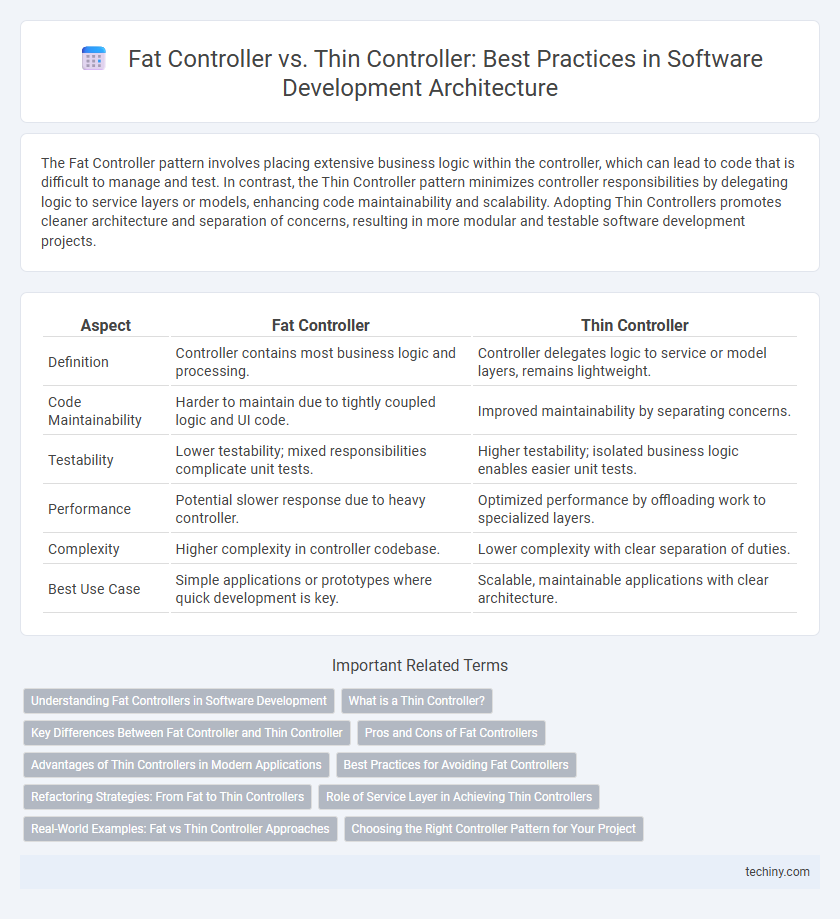The Fat Controller pattern involves placing extensive business logic within the controller, which can lead to code that is difficult to manage and test. In contrast, the Thin Controller pattern minimizes controller responsibilities by delegating logic to service layers or models, enhancing code maintainability and scalability. Adopting Thin Controllers promotes cleaner architecture and separation of concerns, resulting in more modular and testable software development projects.
Table of Comparison
| Aspect | Fat Controller | Thin Controller |
|---|---|---|
| Definition | Controller contains most business logic and processing. | Controller delegates logic to service or model layers, remains lightweight. |
| Code Maintainability | Harder to maintain due to tightly coupled logic and UI code. | Improved maintainability by separating concerns. |
| Testability | Lower testability; mixed responsibilities complicate unit tests. | Higher testability; isolated business logic enables easier unit tests. |
| Performance | Potential slower response due to heavy controller. | Optimized performance by offloading work to specialized layers. |
| Complexity | Higher complexity in controller codebase. | Lower complexity with clear separation of duties. |
| Best Use Case | Simple applications or prototypes where quick development is key. | Scalable, maintainable applications with clear architecture. |
Understanding Fat Controllers in Software Development
Fat Controllers in software development refer to controller components that contain excessive business logic, leading to reduced code maintainability and increased complexity. This design pattern often violates the Single Responsibility Principle, making unit testing more challenging and slowing down development cycles. Understanding the impact of Fat Controllers helps developers refactor code into Thin Controllers by delegating business logic to service layers or models.
What is a Thin Controller?
A thin controller in software development refers to a design approach where the controller contains minimal business logic, delegating data processing and operations to service or model layers. This architecture promotes separation of concerns, improving code maintainability and testability by keeping controllers lightweight and focused on handling user inputs and responses. Thin controllers help enhance application scalability and readability by reducing complexity within the controller layer.
Key Differences Between Fat Controller and Thin Controller
Fat Controller accumulates extensive business logic within the controller, resulting in bulky and harder-to-maintain code, whereas Thin Controller delegates most processing tasks to service or model layers, promoting better separation of concerns. Fat Controllers tend to violate the Single Responsibility Principle by mixing UI handling and business logic, while Thin Controllers streamline request handling, improving testability and scalability. The choice between Fat and Thin Controller architecture significantly impacts application performance, code readability, and maintainability in software development.
Pros and Cons of Fat Controllers
Fat controllers centralize business logic within the controller layer, simplifying the organization of code for smaller applications but often leading to decreased maintainability and scalability as complexity grows. This approach can result in bulky, difficult-to-test controllers, increasing the risk of code duplication and violating the single responsibility principle. However, fat controllers may speed up initial development by reducing the need for extensive service or model layer interaction.
Advantages of Thin Controllers in Modern Applications
Thin controllers improve maintainability and scalability by delegating business logic to dedicated service layers, reducing code complexity within the controller itself. They enhance testability as simpler controllers are easier to isolate and mock during unit testing, leading to more reliable and faster test cycles. Thin controllers also promote clean architecture and separation of concerns, enabling faster development and easier debugging in modern software applications.
Best Practices for Avoiding Fat Controllers
Implementing thin controllers in software development enhances maintainability by delegating business logic to service layers, preventing controllers from becoming bloated or difficult to test. Best practices include extracting complex operations into specialized services or domain models and adhering to the Single Responsibility Principle to keep controller actions concise and focused. Utilizing frameworks that support dependency injection further promotes clean separation of concerns, reducing the risk of fat controllers and improving code readability.
Refactoring Strategies: From Fat to Thin Controllers
Refactoring strategies to transition from fat controllers to thin controllers emphasize extracting business logic and validation rules into service layers or dedicated classes, thereby enhancing code maintainability and testability. Implementing design patterns such as the Single Responsibility Principle (SRP) reduces controller bloat by delegating responsibilities to modular components like use case interactors or domain services. This approach improves scalability and promotes cleaner, more manageable codebases in modern software development.
Role of Service Layer in Achieving Thin Controllers
The service layer centralizes business logic, allowing controllers to remain thin by delegating complex processing tasks away from the presentation layer. This separation enhances maintainability and testability in software development by isolating concerns and reducing controller responsibilities. Implementing a robust service layer streamlines workflows and ensures consistent business rule enforcement across different application modules.
Real-World Examples: Fat vs Thin Controller Approaches
Fat controllers often appear in legacy software projects where business logic is embedded directly within the controller, as seen in early Ruby on Rails applications that handle complex data validations and processing within the controller layer. Thin controllers, promoted in modern frameworks like Django and Laravel, delegate most processing responsibilities to models or service classes, enhancing code maintainability and testability. Real-world examples reveal that thin controller architectures facilitate cleaner separation of concerns and easier scalability, while fat controllers risk becoming bottlenecks and complicate unit testing.
Choosing the Right Controller Pattern for Your Project
Choosing the right controller pattern--Fat Controller or Thin Controller--depends on your project's complexity and maintainability needs. Fat Controllers centralize business logic but can become difficult to manage, while Thin Controllers delegate logic to services or models, improving modularity and testability. Optimize your software architecture by aligning controller responsibilities with project scale and long-term code maintainability requirements.
Fat Controller vs Thin Controller Infographic

 techiny.com
techiny.com